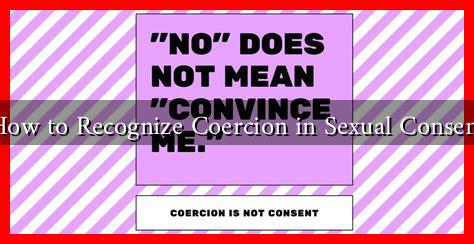-
Table of Contents
How to Recognize Coercion in Sexual Consent
Understanding sexual consent is crucial in fostering healthy relationships and ensuring that all parties feel safe and respected. However, consent is not always straightforward, and coercion can often cloud the lines of agreement. This article aims to shed light on how to recognize coercion in sexual consent, providing valuable insights and practical examples.
What is Coercion?
Coercion refers to the practice of persuading someone to do something by using force or threats. In the context of sexual consent, coercion can manifest in various forms, making it essential to recognize its signs. Coercion undermines the autonomy of individuals, leading to situations where consent is not freely given.
Forms of Coercion in Sexual Consent
Coercion can take many forms, and understanding these can help individuals identify when consent may not be genuine. Here are some common types:
- Emotional Manipulation: This involves using guilt, shame, or emotional blackmail to pressure someone into consenting.
- Threats: Direct threats of harm or consequences if the person does not comply can create a coercive environment.
- Substance Use: Intoxication or drug use can impair judgment, making it difficult for individuals to give informed consent.
- Power Imbalance: Situations where one party holds more power (e.g., in relationships with significant age differences or workplace dynamics) can lead to coercive consent.
Recognizing Signs of Coercion
Identifying coercion can be challenging, especially when it is subtle. Here are some signs to look out for:
- Inconsistent Communication: If someone frequently changes their mind or seems unsure about their feelings, it may indicate they are feeling pressured.
- Fear of Consequences: If a person expresses fear about what might happen if they refuse, this is a significant red flag.
- Reluctance or Hesitation: A lack of enthusiasm or visible discomfort can suggest that consent is not freely given.
- Pressure Tactics: Repeatedly asking or insisting after a person has said no can indicate coercion.
Case Studies and Statistics
Understanding the prevalence of coercion in sexual consent can help highlight its seriousness. According to a study by the National Sexual Violence Resource Center, approximately 1 in 5 women and 1 in 71 men have been raped at some point in their lives. Many of these incidents involve coercive tactics rather than physical force.
In a notable case, a college student reported being pressured into sexual activity by a peer who threatened to spread rumors if she did not comply. This situation exemplifies emotional manipulation and the use of threats as coercive tactics.
How to Foster Healthy Consent
Recognizing coercion is only part of the solution; fostering an environment of healthy consent is equally important. Here are some strategies:
- Open Communication: Encourage honest discussions about boundaries and desires in relationships.
- Educate Yourself and Others: Understanding the nuances of consent can empower individuals to recognize and reject coercive behavior.
- Respect Boundaries: Always respect a person’s right to say no, and never pressure them to change their mind.
- Seek Help if Needed: If you or someone you know is experiencing coercion, consider reaching out to organizations like the Rape, Abuse & Incest National Network (RAINN) for support.
Conclusion
Recognizing coercion in sexual consent is vital for creating safe and respectful relationships. By understanding the forms of coercion, identifying the signs, and fostering healthy communication, individuals can empower themselves and others to navigate consent more effectively. Remember, consent should always be enthusiastic, informed, and freely given. If you suspect coercion in any form, it is essential to seek help and support.
For more information on consent and coercion, visit RAINN’s resource on consent.

